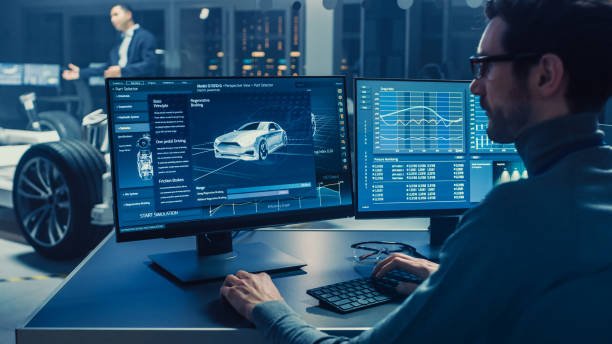What is Autonomous vehicles
vehicles commonly known as self-driving cars are a revolutionary advancement in the field of transportation. These vehicles are equipped with state-of-the-art technologies that enable them to operate without human intervention.The main objective of autonomous vehicles is to increase safety efficiency and convenience in transportation.
what is Autonomous vehicles
Autonomous vehicles -
Autonomous vehicles commonly known as self-driving cars are a revolutionary advancement in the field of transportation. These vehicles are equipped with state-of-the-art technologies that enable them to operate without human intervention.The main objective of autonomous vehicles is to increase safety efficiency and convenience in transportation.
Basic description of autonomous vehicles
1. Sensors and Perception
Autonomous vehicles are equipped with a range of sensors including radar lidar cameras and ultrasonic sensors.These sensors allow the vehicle to sense its surroundings, detect obstacles and interpret traffic situations.
2. Data Processing and Decision Making
Advanced computer systems process data collected by sensors to make real-time decisions. Artificial intelligence (AI) and machine learning algorithms play a key role in enabling vehicles to navigate plan routes and react to dynamic traffic conditions.
3. Connectivity
Autonomous vehicles often rely on connectivity to share information with other vehicles, infrastructure and the cloud. Vehicle-to-vehicle (V2V) and vehicle-to-infrastructure (V2I) communications contribute to more coordinated and efficient traffic flows.
4. Mapping and Localization
High-definition maps combined with GPS and other localization technologies help autonomous vehicles understand their exact location and navigate accurately. These maps include detailed information about road conditions, traffic signs and lane markings.
5. Levels of Autonomy
Most current autonomous vehicles are at Levels 2 and 3 where some driving tasks can be automated but some situations still require human intervention.
Main purpose of autonomous vehicles
1. Security Improvements
The primary goal of autonomous vehicles is to reduce road accidents and fatalities. Advanced sensors and AI algorithms are able to rapidly detect potential hazards allowing the vehicle to make instant decisions to avoid a collision.
2. Efficiency and Traffic Flow
Through real-time communication and coordination these vehicles can navigate intersections and join traffic more efficiently reducing delays and improving overall transportation efficiency.
3. Accessibility and Mobility
This technology can provide increased freedom and accessibility for a broader segment of the population.
4. Environmental Impact
Better traffic flow and more efficient driving patterns can contribute to lower fuel consumption and emissions. Autonomous vehicles have the potential to play a role in creating more environmentally sustainable transportation systems.
5. Productivity and Convenience
Passengers in autonomous vehicles can use their travel time more productively as they no longer need to concentrate on driving. This may increase productivity or the ability to engage in leisure activities while travelling.
6. Economic Impact
The deployment of autonomous vehicles is expected to have a significant economic impact.This could create new employment opportunities in industries related to autonomous vehicle development, maintenance and support services.
Ultimately autonomous vehicles aim to change the landscape of transportation by prioritising safety efficiency and accessibility. As technology advances these vehicles are likely to become increasingly integrated into our daily lives offering a potential shift in how we understand and experience transportation.
Types of autonomous vehicles
Autonomous vehicles - Autonomous vehicles come in different types each with uniqu features and applications.First there are self-driving cars which are probably the most well-known. They use advanced sensors, cameras and AI algorithms to navigate without human input. Additionally autonomous drones are unmanned aerial vehicles that can operate independently for tasks such as surveillance or delivery.
Autonomous buses - Autonomous buses are another type of bus designed to transport passengers without a human driver.These are being tested in urban environments to improve public transportation.Additionally as autonomous trucks are designed to transport goods companies are exploring more efficient and safer long-distance shipping.
Autonomous boats - Autonomous boats and submarines fall into the category of marine autonomous vehicles which serve purposes such as ocean exploration surveillance or environmental monitoring. Finally agricultural autonomous vehicles such as robotic tractors use AI to perform tasks such as planting and harvesting crops.
These types collectively represent a diverse range of autonomous vehicles each of which contributes to the development of transportation and various industries.
What's Your Reaction?




















